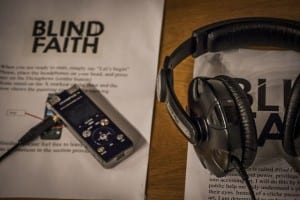
(Instructions on desk Photographer: Fenia Kotsopoulou)
Framing Statement
My performance is called Blind faith. I aim to dismantle the assumptions about power, privilege and knowledge that go into accessing art. I will do this by having a piece’s, but through several other perspectives. By making my audience look closer, I will help them see the true meaning behind these pieces of art, and try and banish any misconceptions they may have.
Are you ready to take this journey with me?
Studying the work of Lundahl and Seitl has greatly influenced my work, but I want to create a new style of artistic performance. “Reliant upon its own participants, each work can never be the same twice and we react singularly to it, always with variation and nuance” (Sharpe, 2015) My performance will rely heavily on my audience and how they interact with the Dictaphone/painting. I want to not only be observed by the public, but have them help me observe; just as Lundahl and Seitl do in their piece Observatory; “In “Observatory” the visitor is fully immersed in a situation being both the observer and the observed, with perception itself as both the medium of the work, its potential content as well as the means to receive it.” (Lundahl-seitl, 2015)
I will be blindfolded for a total of three hours and forty five minutes, and will focus on three four paintings in the museum:
- Does the subject matter – Alfred Munnings (1 hour 10 minutes)
- Ori Gersht – time after time blow up no 12 (55 Minutes)
- Donna Jones – ground zero (50 minutes)
- Richard Billingham – untitled (ral 50) (50 minutes)
My performance started at ten forty five in the Viewpoints gallery in the Collection. My recorded track was 3:00 minutes long, plus stoppages when instructed, so my piece ran for approximately 5 minutes in total. This is dependent on how long the audience member wanted to take when describing the painting.
I chose to use a Dictaphone for my audio track to be played on, as it felt a lot less formal, and the sound aspect was something I was interested in. This is because although edited, I was interested in the sound effect the Dictaphone would give as I wanted them to focus only on the painting, but still have the surrounding setting as an aspect.
I wanted this to be a One to One performance; “Quite simply, “One to One” or “One on One” or “Audience of One” are all terms used to describe a performance that invites one audience member to experience the piece on their own.” (Zerihan, 2009) this made the performance feel significantly beneficial, as if too many audience members were involved, not all the information may come across. This is also due to using a set of headphones, by having this secluded setting, the audience member will be a lot more focused, and can take their time.
(Audience Interaction: Photgrapher – Fenia Kotsopoulou)
An Analysis of Process
“Site-specificity, then, can be understood in terms of this process, while a ‘site-specific work’ might articulate and define itself through properties, qualities or meanings produced in specific relationships between an ‘object’ or ‘event’ and a position it occupies” (Kaye, 2000, 1)
Pearson states “There are then new kinds of site, more or less stable, within and through which performance can be enacted – and new kinds of (performative) relationship within and through which site might (temporally) materialize.” (Pearson, 2010, 14) The site we were assigned to perform in was The Collection and Usher Gallery. This immediately opened so many doors of potential for performance.
My first initial concept of site specific performance was “the material traces evoke worlds that are intangible and unlocatable: worlds of memory, pleasure, sensation, imagination, affect and insight” (Pearson, 2010, 10). Site specific performance is about recapturing the historical value of a site with a no performance origin such as: a cathedral, the high street and in our case, a museum. Performing in a museum was always going to be tough due to a number of restrictions that are implemented on the site.
So, on a cold morning on the 28th of January, I and my fellow performers embarked on a journey to the collection and usher museum. This is located just off of the high street, about 2/3 minutes to be exact. Walking into the reception of this monumental building was both astonishing and breath taking. We were met by a noise of children yelling and the smell of the beautiful cafe just to our left.
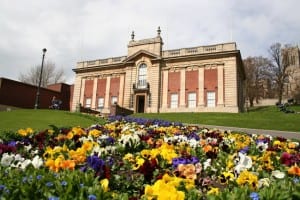
(photo available from: http://cityfocus.blogs.lincoln.ac.uk/files/2012/05/usher-gallery.jpg)
We were then led into one of the side rooms by our lecturer, where we then began a discussion about what is expected of us and all the do’s/don’ts in the museum. We then met Ash, one of the guys working for the university, we then began to discuss about the new gallery being opened just across the hall. We were all in for a treat; we were given access to the gallery a few days before it was being officially unveiled to the public. When walking in, we were met by a wall of fresh smells and a mist of pure colour.
On first glimpse the main thing that stood out was a giant blue square in the back left corner, that hadn’t yet had its description placed upon the wall, which aggravated many questions from us all. After a few minutes, we were rounded up and herded out. After this brilliant experience we were given a task, of finding 3 things in both sites, and creating a 1 minute performance from them. i found my task relatively easy, apart from one question… “What part of the museum is the most meaningful?” This to me was tough, due to slight confusion, I wasn’t sure whether to ask a worker or use my own opinion. After much collaboration, I decided to my own opinion and work it into my piece of work.
After working for just a few hours in the museum, I gained so much knowledge of its history and its future. However, I was taken back by the phrase “this is a place where art goes to die” as for me, this is both true, yet severely false, and this is something I will be taking forward when devising my site specific performance.
From the first week in the museum, the main things I felt inspired by were the big blue canvas, which I didn’t originally know the name of, and the phrase “this is a place where art goes to die”. With my performance and process, I wanted to disprove this theory that many people seemed to share.
One of my main fears with this module was that being a stage actor, I like stability, I like scripts and performing. But this module seemed like it was pushing towards performance art, and on a personal level, this is something I have never really taken a huge interest in; “Performance art is where an artist uses their own body as a art medium and the artwork takes the form of actions performed by the artist” (Tate, 2015) this is something I had never experienced as an actor, and made me feel very hesitant towards this module.
One of the main practitioners I wanted to work with was Marina Abramović, and her performance Rhythm 0. My initial idea of performance was to be called The Artist is the Art: Breaking Barriers, I was to be in minimal clothing, maybe just a pair of boxers, I was going to be surrounded by different forms of creating art:
- Paint
- Felt pens
- Spray paint cans
- Sticky notes
- Glue
- Accessories (glitter, stars, stickers)
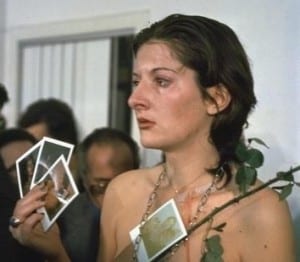
(available from https://minyilee.wordpress.com/2013/02/20/marina-abramovic-rhythm-0-1974/)
I wanted to become a canvas, and have the audience turn me into a piece of art right infront of their eyes. This was similar to Abramovic’s Rhythm 0; “Abramović allowed herself to be manipulated by the public in any way they chose, using a range of objects laid on a table, such as grooming tools, food and weapons.” (Tate, 2015) I wanted to take a less extreme approach to this performance; I wanted the audience to have a little bit of fun with the performance, but still create the message that anyone can both create and be a part of art.
Although I was very optimistic about this idea for a performance, it sadly didn’t materialise. After a chat with Ally, we discussed the performance values of the piece, and its overall presence came across as slightly pretentious. It also came down to certain restrictions from our site, there was not any practical places at the museum for me to perform this type of performance without being outside and having certain health and safety problems. So we continued chatting and came up with the concept of a blindfolded tour of the museum. My idea was to be blindfolded, stand in the foyer and have people collect me, and take me to their favourite piece of art in the museum, and then lead me to their least favourite piece of art, then give me a full description of why they did and didn’t like these two pieces. This idea for a performance was intriguing as I was very interested to see what people did and didn’t like in the galleries and the reasons why. This was because I thought people may take me to the same pieces over and over again, but for very different reasons.
I felt that this performance would add a new type of art to the galleries; “The architecture of a gallery, in which the work must take shape, is perhaps not only the actual exhibition” (Kaye, 2000, 193) but after our pitch to Conan, we discovered there were very serious health and safety issues. Due to a number of staircases and trip hazards, an aspect of this performance had to be changed, so instead of being led around the museum, I was to choose five pieces of art to stand by, and have people talk to me about in depth. However, with the changes, I still thought it would be a good idea to keep the blindfold as it added another level to this performance.
Soon after finalising what my performance will be, it dawned on me that by performing in the gallery, we were becoming apart of the exhibition itself. This meant that what we were creating had to be of an immensely high standard; otherwise we won’t do the pieces around us any justice. I knew extensive research was crucial to my piece; so to start off, I began researching practitioners and performances that were similar to mine.
Michael Pinchbecks’ Sit with me for a moment and remember; “You are invited to sit on the bench to listen to a recording that reflects on what it means to sit for a moment and remember. Site-specific piece presented in Derby, Leicester, Manchester, Nottingham and Sheffield.” (Pinchbeck, 2015) I wanted to work with the idea of taking someone out of the situation they were in, but instead of making them remember, I wanted to make them view art closer.
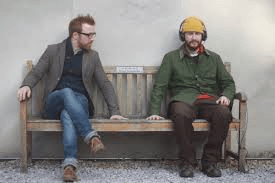
(available from: http://michaelpinchbeck.co.uk/sit-with-me-for-a-moment/)
The first thing I had to do, was script my recording, this became more challenging than first thought. The recording needed to be inviting yet thorough with the audience. I felt I needed to start off by first introducing myself and the values of my piece; “Hello, My name is Paul Slodczyk. As you can see, I’m blindfolded, I need you to be my eyes and help me not only see the piece, but see past the surface of it.” (Slodczyk, 2015) by introducing myself I felt this was more inviting and more approachable for an audience member. After a chat with Ally, we discussed how I needed to delay pauses when needed, and to add in a practise stop and start in the beginning, just to ease the audience into the process.

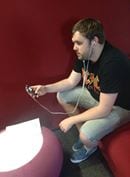
(1st recording attempt: Photographer – Charlotte Spragg)
Next was actually recording my script. This, in total, took four attempts. The first, although was good, did not download fully and could not be recovered, so we had to start again. The next two attempts were ruined by mistakes from me, saying words wrong and forgetting to say certain words. However, the forth attempt was spot on, after some editing, the sound was good, the background noise of the museum suited it nicely, and I kept to the script word for word. I researched previous performances when practicing the voice recording. Listening to other practitioners and voice actors was very beneficial in my process because it gave me an idea on how to portray my voice. Listening to pieces such as Michael Pinchbecks’ Sit with me for a moment and remember, and Lundahl and Seitl’s Observatory. Both of these pieces aided me as the voice actors really set a high standard, and I wanted to achieve this standard with my own voice.
Now all that was left was to practice with members of the public. On the 25th of April at ten forty five in the morning, I ventured up to the museum to have a pre dress run. I stood blindfolded in the museum for a total of forty minutes. This was more challenging than I first thought; I had to rely on my hearing to get through. Taking away one of the key senses is not something that is easy to do, but getting through his made confident about my final piece.
On the 8th of May, we began out technical and dress rehearsal at the Collection gallery. The main thing I had to take into account was that the museum was still open to the public; and these people were here for the art. “The Collection brings together an award winning archaeology museum and the region’s premier art gallery”. (Thecollectionmuseum, 2015) as well as viewing the pieces herself, Ally brought along another lecturer, Karen Savage. When she viewed my piece, there at first was minor confusion, but when this was sorted, she fully engaged with it; leaving the comment “Karen Savage – I think my interpretation was good. Thank you for making me look harder” (Slodczyk, 2015) these comments made me feel like I was on track with what I wanted to achieve with my performance.
(Audience Interaction: Photgrapher – Fenia Kotsopoulou)
A Performance Evaluation
(Audience Interaction: Photgrapher – Fenia Kotsopoulou)
My performance on the 9th of May 2015 last for a duration of three hours and forty five minutes. Over this period I had seventeen people take part in my performance in total, and ten people left comments on the provided paper. Although a few of the audience members found it hard to engage with the piece; “Heidi Green – I liked the performance, but I found it difficult to describe the painting in detail” (Slodczyk, 2015) this was a minimal issue though, as almost every other participant engaged with the piece really well; “Ciara Beighton – I liked the simplicity of the piece. Taking something as subjective as art and trying to interpret it is really interesting”. (Slodczyk, 2015) I feel overall my performance was a huge success, I wasn’t anticipating so many people to take part, and I also wasn’t expecting some of the interaction I got.
For the first painting I performed with, Does the subject matter by Alfred Munnings, received five participants throughout the one hour and ten minutes I was performing. This piece received such a varied reception, as although a brilliant painting, aspects of it were very confusing. However, these varying factors are what enticed me to perform with this painting. The only problematic participants I had were two young girls, instead of actually taking part; they began to mess about and record themselves talking to each other. This became problematic, as to stop them doing this, I had to break character to rectify what they had done. These were the only two participants who didn’t follow the instructions that were provided on the sheet I provided.
(Audience Interaction: Photgrapher – Fenia Kotsopoulou) (Final Performance – equipment on desk: Photgrapher – Fenia Kotsopoulou)
If I were to perform Blind Faith again, I would make a few changes to the piece. I would re-word my script, as a few people mentioned that there was a slight cross over with descriptions as they went into great depth with the first part of the recording. Even though slight confusion, the majority of my audience carried on and seemed to differ in descriptions. I would also change the duration of my piece, I would be blindfolded for longer, but also have longer brakes in between. This is due to after the third piece, I began to feel slightly dizzy due to the heat in the gallery, and the blindfold slightly affected my breathing. But other than these minor issues, I felt the atmosphere in the gallery really highlighted my piece. The silence in the room was at times deafening, but the occasional buzz of a fan reminded me about the surroundings around me. I relied mostly on my other senses, listening carefully was the main difficulty, I would only be able to embrace the audience after they said “Let’s begin” (Slodczyk, 2015)
To conclude, I felt I interacted with my site very well, I chose four paintings that will never be hung in another gallery in that specific order again. I also choose these paintings by the impression that they gave off, in a very secluded room, these paintings seemed to fill it with their presence. The main thing I wanted to change is the number of people who simply walk through and just skim past the paintings, I wanted to help them really view them and try to truly understand them. By having a participant try to depict what is happening in a painting, and try to work out its artistic values will help them understand the painting to a greater standard. If people just stop for that extra minute and take their time viewing the artwork, they will truly benefit from this and will truly understand the piece.
Instead of being passive and not truly engaging and understanding the paintings, I wanted people to lose themselves within the pieces. “A museum is a place where one should lose one’s head.” (Piano, 2009)
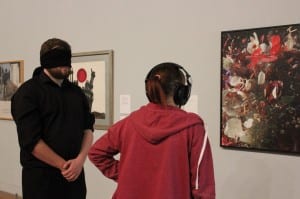

(Audience Interaction: Photgrapher – Charlotte Spragg)
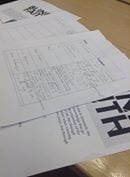
(Final Documentation: Photographer – Charlotte Spragg)
Citations:
- Kaye, N. (2000). Site-specific art, Performance, place and documentation. London: Routledge.
- Lundahl-seitl, (2015). Observatory | Lundahl & Seitl. [online] Available at: http://www.lundahl-seitl.com/work/observatory [Accessed 7 May 2015].
- Pearson, M. (2010). Site-specific performance. Houndmills, Basingstoke, Hampshire: Palgrave Macmillan.
- Piano, R. (2009). Architect Day: Renzo Piano. [online] Abduzeedo Design Inspiration. Available at: http://abduzeedo.com/architect-day-renzo-piano [Accessed 3 May 2015].
- Pinchbeck, M. (2015). Sit with me for a moment and remember | Michael Pinchbeck. [online] Available at: http://michaelpinchbeck.co.uk/sit-with-me-for-a-moment/ [Accessed 5 May 2015].
- Sharpe, G. (2015). My Voice | Lundahl & Seitl. [online] Lundahl-seitl. Available at: http://www.lundahl-seitl.com/work/my-voice [Accessed 6 May 2015].
- Slodczyk, P. (2005) Blind Faith. [Performance Art] Lincoln, England: Collection and Usher Gallery,8 and 9 May
- Tate, (2015). Performance art. [online] Available at: http://www.tate.org.uk/learn/online-resources/glossary/p/performance-art [Accessed 6 May 2015].
- Tate, (2015). Marina Abramović, Rhythm 0 1974. [online] Available at: http://www.tate.org.uk/whats-on/tate-liverpool/display/dla-piper-series-constellations/marina-abramovic-rhythm-0-1974 [Accessed 4 May 2015].
- Thecollectionmuseum, (2015). Visiting The Collection | The Collection. [online] Available at: http://www.thecollectionmuseum.com/?/visiting-us [Accessed 15 May 2015].
- Zerihan, R (2009) Live Art Development Agency Study Room Guide on ONE TO ONE PERFORMANCE. [case study] London. Live Art Development Agency

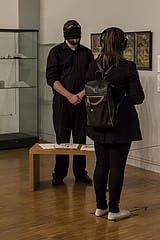
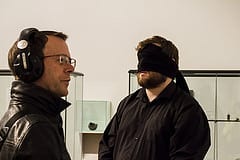
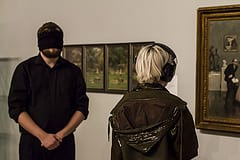
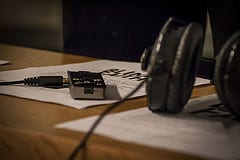
Recent Comments